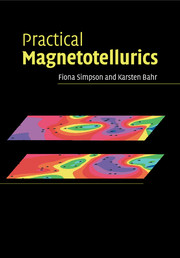Book contents
- Frontmatter
- Contents
- Preface
- Symbols
- 1 Introduction
- 2 Basic theoretical concepts
- 3 Planning a field campaign
- 4 From time series to transfer functions: data processing
- 5 Dimensionality and distortion
- 6 Numerical forward modelling
- 7 Inversion of MT data
- 8 The general link to other geosciences: conduction mechanisms
- 9 The special link to other geosciences
- 10 Other EM induction techniques
- Appendix 1 Theorems from vector calculus
- Appendix 2 The transfer function in the wavenumber-frequency domain and equivalence transfer functions
- Appendix 3 Probability distributions
- Appendix 4 Linear regression
- Appendix 5 Fourier analysis
- Appendix 6 Power and cross spectra
- Glossary
- References
- Index
10 - Other EM induction techniques
Published online by Cambridge University Press: 03 December 2009
- Frontmatter
- Contents
- Preface
- Symbols
- 1 Introduction
- 2 Basic theoretical concepts
- 3 Planning a field campaign
- 4 From time series to transfer functions: data processing
- 5 Dimensionality and distortion
- 6 Numerical forward modelling
- 7 Inversion of MT data
- 8 The general link to other geosciences: conduction mechanisms
- 9 The special link to other geosciences
- 10 Other EM induction techniques
- Appendix 1 Theorems from vector calculus
- Appendix 2 The transfer function in the wavenumber-frequency domain and equivalence transfer functions
- Appendix 3 Probability distributions
- Appendix 4 Linear regression
- Appendix 5 Fourier analysis
- Appendix 6 Power and cross spectra
- Glossary
- References
- Index
Summary
We finally pay a few other induction techniques a short visit. Magnetometer array studies have been conducted in many parts of the world. Interpretation of the data acquired is mostly restricted to an estimation of the amplitude of the vertical magnetic variational field relative to the amplitude of the horizontal magnetic variational fields, displayed as ‘induction vectors’. The interpretation of these data in terms of lateral conductivity contrasts has been rather qualitative, but if regional differences of the horizontal variational fields of different sites are also evaluated, then ‘geomagnetic depth sounding’ (GDS) provides quantitative information complementary to MT data. Appealingly, the additional information comes at no extra cost: a group conducting an MT campaign with more than one instrument can use the data so acquired for GDS with no additional hardware or field procedures. We demonstrate how the existing processing and interpretation schemes can be modified with only very minor changes. On a more historical note, simultaneous measurements of the magnetic field at the Earth's surface and in boreholes have provided a means of studying the exponential decay of magnetic fields within the Earth (for those who doubt the action of the skin effect).
A fascinating experience is the evaluation of the magnetic daily variation, caused by current vortices in the ionosphere. In this case, the plane wave assumption is violated (the penetration depth – 600 km – is not really very small compared to the size of the ionic current vortices – 6000 km), but this can be turned to advantage.
Information
- Type
- Chapter
- Information
- Practical Magnetotellurics , pp. 181 - 192Publisher: Cambridge University PressPrint publication year: 2005
